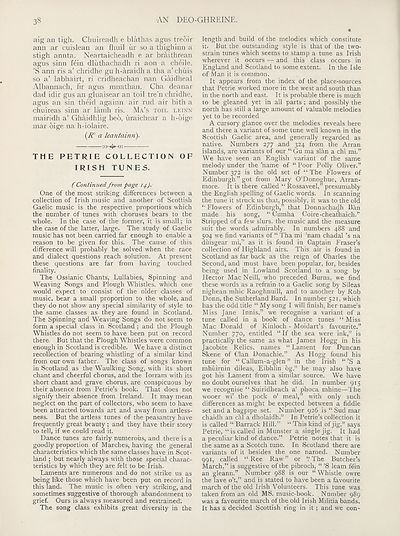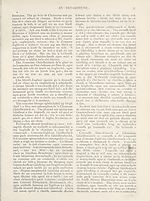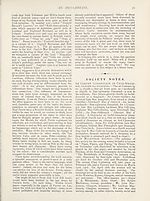An Comunn Gàidhealach Publications > Deo-gréine > Volume 1, October 1905-September 1906
(50) Page 38
Download files
Complete book:
Individual page:
Thumbnail gallery: Grid view | List view

38
•AN DEO-GHREINE.
aig an tigh. Chuireadh e blathas agus tredir
ann ar cuislean an fhuil ur so a thighinn a
stigh annta. Neartaicheadh e ar braithrean
agus sinn fein dluthachadh ri aon a cheile.
’S ann ris a’ chridhe gu h-araidh a tha a’ chuis
so a’ labhairt, ri cridheachan nan Gaidheal
Albannach, fir agus mnathan. Cha deanar
dad idir gus an gluaisear an toil tre’n chridhe,
agus an sin theid againn air rud air bith a
chuireas sinn ar lamh ris. Ma’s toil leinn
mairidh a’ Ghaidhlig bed, uraichear a h-dige
mar dige na h-iolaire.
{Ry a leantainn).
THE PETRIE COLLECTION OF
IRISH TUNES.
( Continued from page 14).
One of the most striking differences between a
collection of Irish music and another of Scottish
Gaelic music is the respective proportions which
the number of tunes with choruses bears to the
whole. In the case of the former, it is small; in
the case of the latter, large. The study of Gaelic
music has not been carried far enough to enable a
reason to be given for this. The cause of this
difference will probably be solved when the race
and dialect questions reach solution. At present
these questions are far from having touched
finality.
The Ossianic Chants, Lullabies, Spinning and
Weaving Songs and Plough Whistles, which one
would expect to consist of the older classes of
music, bear a small proportion to the whole, and
they do not show any special similarity of style to
the same classes as they are found in Scotland.
The Spinning and Weaving Songs do not seem to
form a special class in Scotland; and the Plough
Whistles do not seem to have been put on record
there. But that the Plough Whistles were common
enough in Scotland is credible. We have a distinct
recollection of hearing whistling of a similar kind
from our own father. The class of songs known
in Scotland as the Waulking Song, with its short
chant and cheerful chorus, and the lorram with its
short chant and grave chorus, are conspicuous by
their absence from Petrie’s book. That does not
signify their absence from Ireland. It may mean
neglect on the part of collectors, who seem to have
been attracted towards art and away from artless¬
ness. But the artless tunes of the peasantry have
frequently great beauty ; and they have their story
to tell, if we could read it.
Dance tunes are fairly numerous, and there is a
goodly proportion of Marches, having the general
characteristics which the same classes have in Scot¬
land ; but nearly always with those special charac¬
teristics by which they are felt to be Irish.
Laments are numerous and do not strike us as
being like those which have been put on record in
this land. The music is often very striking, and
sometimes suggestive of thorough abandonment to
grief. Ours is always measured and restrained.
The song class exhibits great diversity in the
length and build of the melodies which constitute
it. But the outstanding style is that of the two-
strain tunes which seems to stamp a tune as Irish
wherever it occurs — and this class occurs in
England and Scotland to some extent. In the Isle
of Man it is common.
It appears from the index of the place-sources
that Petrie worked more in the west and south than
in the north and east. It is probable there is much
to be gleaned yet in all parts ; and possibly the
north has still a large amount of valuable melodies
yet to be recorded
A cursory glance over the melodies reveals here
and there a variant of some tune well known in the
Scottish Gaelic area, and generally regarded as
native. Numbers 277 and 324 from the Arran
islands, are variants of our “ Gu ma slhn a chi mi.”
We have seen an English variant of the same
melody under the name of “ Poor Polly Oliver.”
Number 372 is the old set of “The Flowers of
Edinburgh ” got from Mary O’Donoghue, Arran-
more. It is there called “ Rossaveel,” presumably
the English spelling of Gaelic words. In scanning
the tune it struck us that, possibly, it was to the old
*• Flowers of Edinburgh,” that Donnacha^h Bhn
made his song, “ Cumha Coire-cheathaich.”
Stripped of a few slurs, the music and the measure
suit the words admirably. In numbers 488 and
504 we find variants of “ Tha mi ’nam chadal’s na
duisgear mi,” as it is found in Captain Fraser’s
collection of Highland airs. This air is found in
Scotland as far back as the reign of Charles the
Second, and must have been popular, for, besides
being used in Lowland Scotland to a song by
Hector Mac Neill, who preceded Burns, we find
these words as a refrain to a Gaelic song by Sileas
nighean mhic Raoghnuill, and to another by Rob
Donn, the Sutherland Bard. In number 521, which
has the odd title “ My song I will finish, her name’s
Miss Jane Innis,” we recognise a variant of a
tune called in a book of dance tunes “ Miss
Mac Donald of Kinloch - Moidart’s favourite,”
Number 770, entitled “If the sea were ink,” is
practically the same as what James Hogg in his
Jacobite Relics, names “ Lament for Duncan
Skene of Clan Donachie.” As Hogg found his
tune for “ Callum-a-glen ” in the Irish “ ’S a
mhitirnin dileas, Eibhlin 6g,” he may also have
got his Lament from a similar source. We have
no doubt ourselves that he did. In number 915
we recognise “ Suiridheach a’ phoca mhine—The
wooer wi’ the pock o’ meal,” with only such
differences as might be expected between a fiddle
set and a bagpipe set. Number 926 is “ Sud mar
chaidh an chi a dholaidh.” In Petrie’s collection it
is called “ Barrack Hill.” “ This kind of jig,” says
Petrie, “is called in Munster a single jig. It had
a peculiar kind of dance.” Petrie notes that it is
the same as a Scotch tune. In Scotland there are
variants of it besides the one named. Number
991, called “ Ree Raw” or ‘.‘The Butcher’s
March,” is suggestive of the pibroch, “ ’S learn fdin
an gleann.” Number 988 is our “Whistle owre
the lave o’t,” and is stated to have been a favourite
march of the old Irish Volunteers. This tune was
taken from an old MS. music-book. Number 989
was a favourite march of the old Irish Militia bands.
It has a decided Scottish ring in it; and we con-
•AN DEO-GHREINE.
aig an tigh. Chuireadh e blathas agus tredir
ann ar cuislean an fhuil ur so a thighinn a
stigh annta. Neartaicheadh e ar braithrean
agus sinn fein dluthachadh ri aon a cheile.
’S ann ris a’ chridhe gu h-araidh a tha a’ chuis
so a’ labhairt, ri cridheachan nan Gaidheal
Albannach, fir agus mnathan. Cha deanar
dad idir gus an gluaisear an toil tre’n chridhe,
agus an sin theid againn air rud air bith a
chuireas sinn ar lamh ris. Ma’s toil leinn
mairidh a’ Ghaidhlig bed, uraichear a h-dige
mar dige na h-iolaire.
{Ry a leantainn).
THE PETRIE COLLECTION OF
IRISH TUNES.
( Continued from page 14).
One of the most striking differences between a
collection of Irish music and another of Scottish
Gaelic music is the respective proportions which
the number of tunes with choruses bears to the
whole. In the case of the former, it is small; in
the case of the latter, large. The study of Gaelic
music has not been carried far enough to enable a
reason to be given for this. The cause of this
difference will probably be solved when the race
and dialect questions reach solution. At present
these questions are far from having touched
finality.
The Ossianic Chants, Lullabies, Spinning and
Weaving Songs and Plough Whistles, which one
would expect to consist of the older classes of
music, bear a small proportion to the whole, and
they do not show any special similarity of style to
the same classes as they are found in Scotland.
The Spinning and Weaving Songs do not seem to
form a special class in Scotland; and the Plough
Whistles do not seem to have been put on record
there. But that the Plough Whistles were common
enough in Scotland is credible. We have a distinct
recollection of hearing whistling of a similar kind
from our own father. The class of songs known
in Scotland as the Waulking Song, with its short
chant and cheerful chorus, and the lorram with its
short chant and grave chorus, are conspicuous by
their absence from Petrie’s book. That does not
signify their absence from Ireland. It may mean
neglect on the part of collectors, who seem to have
been attracted towards art and away from artless¬
ness. But the artless tunes of the peasantry have
frequently great beauty ; and they have their story
to tell, if we could read it.
Dance tunes are fairly numerous, and there is a
goodly proportion of Marches, having the general
characteristics which the same classes have in Scot¬
land ; but nearly always with those special charac¬
teristics by which they are felt to be Irish.
Laments are numerous and do not strike us as
being like those which have been put on record in
this land. The music is often very striking, and
sometimes suggestive of thorough abandonment to
grief. Ours is always measured and restrained.
The song class exhibits great diversity in the
length and build of the melodies which constitute
it. But the outstanding style is that of the two-
strain tunes which seems to stamp a tune as Irish
wherever it occurs — and this class occurs in
England and Scotland to some extent. In the Isle
of Man it is common.
It appears from the index of the place-sources
that Petrie worked more in the west and south than
in the north and east. It is probable there is much
to be gleaned yet in all parts ; and possibly the
north has still a large amount of valuable melodies
yet to be recorded
A cursory glance over the melodies reveals here
and there a variant of some tune well known in the
Scottish Gaelic area, and generally regarded as
native. Numbers 277 and 324 from the Arran
islands, are variants of our “ Gu ma slhn a chi mi.”
We have seen an English variant of the same
melody under the name of “ Poor Polly Oliver.”
Number 372 is the old set of “The Flowers of
Edinburgh ” got from Mary O’Donoghue, Arran-
more. It is there called “ Rossaveel,” presumably
the English spelling of Gaelic words. In scanning
the tune it struck us that, possibly, it was to the old
*• Flowers of Edinburgh,” that Donnacha^h Bhn
made his song, “ Cumha Coire-cheathaich.”
Stripped of a few slurs, the music and the measure
suit the words admirably. In numbers 488 and
504 we find variants of “ Tha mi ’nam chadal’s na
duisgear mi,” as it is found in Captain Fraser’s
collection of Highland airs. This air is found in
Scotland as far back as the reign of Charles the
Second, and must have been popular, for, besides
being used in Lowland Scotland to a song by
Hector Mac Neill, who preceded Burns, we find
these words as a refrain to a Gaelic song by Sileas
nighean mhic Raoghnuill, and to another by Rob
Donn, the Sutherland Bard. In number 521, which
has the odd title “ My song I will finish, her name’s
Miss Jane Innis,” we recognise a variant of a
tune called in a book of dance tunes “ Miss
Mac Donald of Kinloch - Moidart’s favourite,”
Number 770, entitled “If the sea were ink,” is
practically the same as what James Hogg in his
Jacobite Relics, names “ Lament for Duncan
Skene of Clan Donachie.” As Hogg found his
tune for “ Callum-a-glen ” in the Irish “ ’S a
mhitirnin dileas, Eibhlin 6g,” he may also have
got his Lament from a similar source. We have
no doubt ourselves that he did. In number 915
we recognise “ Suiridheach a’ phoca mhine—The
wooer wi’ the pock o’ meal,” with only such
differences as might be expected between a fiddle
set and a bagpipe set. Number 926 is “ Sud mar
chaidh an chi a dholaidh.” In Petrie’s collection it
is called “ Barrack Hill.” “ This kind of jig,” says
Petrie, “is called in Munster a single jig. It had
a peculiar kind of dance.” Petrie notes that it is
the same as a Scotch tune. In Scotland there are
variants of it besides the one named. Number
991, called “ Ree Raw” or ‘.‘The Butcher’s
March,” is suggestive of the pibroch, “ ’S learn fdin
an gleann.” Number 988 is our “Whistle owre
the lave o’t,” and is stated to have been a favourite
march of the old Irish Volunteers. This tune was
taken from an old MS. music-book. Number 989
was a favourite march of the old Irish Militia bands.
It has a decided Scottish ring in it; and we con-
Set display mode to:
![]() Universal Viewer |
Universal Viewer | ![]() Mirador |
Large image | Transcription
Mirador |
Large image | Transcription
| An Comunn Gàidhealach > An Comunn Gàidhealach Publications > Deo-gréine > Volume 1, October 1905-September 1906 > (50) Page 38 |
|---|
| Permanent URL | https://digital.nls.uk/125242512 |
|---|
| Description | Leabhar 1, An deicheamh mios 1, 1905 gu Mios Meadhonach an Fhoghair 1906. |
|---|---|
| Attribution and copyright: |
|
| Description | This contains items published by An Comunn, which are not specifically Mòd-related. It includes journals, annual reports and corporate documents, policy statements, educational resources and published plays and literature. It is arranged alphabetically by title. |
|---|
| Description | A collection of over 400 items published by An Comunn Gàidhealach, the organisation which promotes Gaelic language and culture and organises the Royal National Mòd. Dating from 1891 up to the present day, the collection includes journals and newspapers, annual reports, educational materials, national Mòd programmes, published Mòd literature and music. |
|---|---|
| Additional NLS resources: |
|

